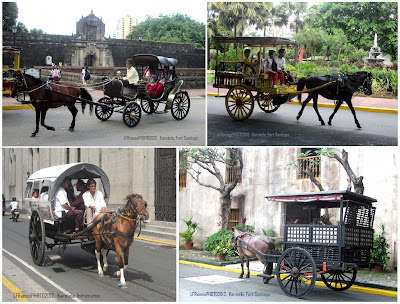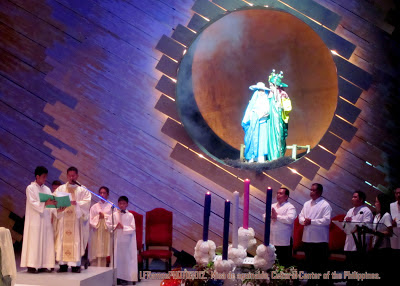 |
| This is a Filipinized version of the belen (Bethlehem, nativity scene). The lechon view reminds that Christmas in the Philippines is an occasion for family reunions and a roasted pig is a center piece of the food table. [This belen is one in a collection on exhibit at the Arzobispado de Manila.] |
More than half a century ago, Paskua (Christmas) to us kids in the old
hometown seemed to take too long in coming.
When we learned to reckon its approach with the onset of the '-ber'
months, we have already lost the pure, innocent joy of waiting.
We can’t remember exactly what our great
expectations were while the nights were turning colder, and we would need to
wear a pranela (sweater) when we go
caroling or simply prowling around with the neighborhood kids.
We were told to behave properly so that Santa Claus would
bring us gifts come Christmas. We have
no recollection if Santa Claus ever came at all through the windows or the
galvanized iron roof of our house of buho
walls and bamboo stairs, but there would be something inside the socks we were asked to hang before we went to sleep on Chrismas eve.
Our memory tells us that we always wore a
white polo shirt on Christmas. Inang
took care, we now think, to shield us from the usual taunts, no matter how
friendly these were, of older relatives that loud colors do not seemingly match our earth-brown
skin tone.
In those days when we went to school in
wooden clogs, and later in rubber sandals, Christmas was the only occasion when
we had to wear shoes despite our loud protestations. Many a time did we suffer blisters at the
back of our feet just because we had to look our angelic best on Christmas day. The shoes could have been ill-fitting because they were bought based on the patterns traced around our feet on paper.
In our six Christmases at the San
Jose-Patrocinio Elementary School, our Christmas tree, just like in most of the
pupils’ homes, was the lowly kuribetbet (a.k.a. pandakaki) shrub shorn of all its leaves. Bands of
green crepe paper cut in such manner as to yield a leafy effect were wound around the stem and
branches producing
an evergreen tree on which to hang colored, usually red, paper balls and
bells.
At home, we'd ask our Inang why we couldn’t have
an aru-o (aguho, false pine) branch for a
tree, just like in other houses. We soon found out she didn't like the needles turning brown even before the Misa de Gallo or dawn masses have started.
In later years, the bare kuribetbet would be painted all white,
probably as a matter of fashion rather than as tangible proof of one’s
‘dreaming of a white Christmas.’ In high
school, we did this as a matter of convenience; it did not take long to finish
it.
Industrial arts projects in December
invariably would be a parol (lantern),
usually the simple bamboo star. We would
cover our projects with colored Japanese paper or cellophane and attached the rayos (rays) made of the same paper at
two adjacent points of the star.
Sometimes, we would put a rim attached to all five points of the
star. Some would put a belen picture at the middle, or
some other decorative paper cut-outs all over.
When schools closed for the Christmas vacation, we would bring home our
lanterns to be hung by the window.
The belen (nativity scene) was not yet a common Christmas home decoration during our growing up years. We saw them only in the church without the baby in the manger until the misa de aguinaldo or midnight mass on Christmas eve. Many times did we fail to keep awake for the midnight (yes, at twelve o'clock exactly) mass when the church was dimmed at some point and a lighted parol moved above us from the choir loft to the nativity scene by the altar.
Our generation started schooling with
English as medium of instruction.
Our first Christmas song
was “Silent Night.” We were already in
the university when we learned “Ang Pasko
ay Sumapit.” Thus the Christmas jingles that came with
the early evening air in our childhood days were the strains of ‘ol is cam, ol is brayt’ as we, the
neighborhood kids, went house-to-house caroling about the oli impan (holy infant). We
could be happy with a five-centavo token from each house.
Stingy house owners would get a musical
rapping from us --
Bulong ti apatot, Leaves of apatot plant,
Paskuayo a naimot. Gifts to stingy
people.
Umulog ti makarurod Come
down if your angy,
Ta narnaran ti dandanog. And we’ll beat you with our
fists.
-- as we ran away, scared that they would
come down and face our dare.
When we taught at a hometown high school in the early 70s, we
sang with the Saint Cecilia’s Choir of our Roman Catholic parish. This was when we learned
to sing an antique Ilocano carol, simply called 'Rambakan' (Celebrate).
Most probably, it was the popular song among the town folks before they began to love the carols that they learned from the Americans during what they reminisced as peacetime before the second world war.
Some words in the lyrics are archaic
Ilocano. The chorus of the indigenous carol is an
invitation to celebrate the Lord’s birth and to proclaim his power and glory –
Rambakan tay a pada-pada Let us all celebrate
Panakay-yanak to Dios
ditoy daga The birth of God on earth.
Umadani tay met kenkuana Let us all go to
Him
Idir-i tay tan-ok ken gloriana proclaiming his
power and glory.
The two narrative stanzas speak of His
humility and mercy --
Ay dimtengen a ti Dios Apo Ay, the Lord God has come
Simnek kaasi na kadatayo. Because of His mercy to
all of us.
Ti Mesias manipud ngato The Messiah from above
Immay nga'd la makipagbiag came down to live with us.
kadatayo.
Maysa a rukib a paglinungan A cave
that serves as shed
Ti kinayatna nga makapanganakan, He preferred to be
born in;
Ket kuloong met laeng piman And merely
a manger
Ti inna pinili a nagid-daan. He
chose to sleep in.
Before “Ang
Pasko ay Sumapit” became the de rigeur anthem at the close of the nine-day Christmas masses, churchgoers sang the “Rambakan”
in cheerful chorus as they troop out of church, greeting each and everyone
along the way with “Naimbag a Paskuayo!”
Early morning of Christmas day, children went around town greeting household owners with Paskuami,
apo! (Our gifts, sir!) Those were the days when they give candies so we had pockets full of them by mid-morning. We also expected but we dreaded receiving native suman, too bulky to carry around even if one had a paper bag. We were asked to go and greet our godparents but we were too shy to do that. On a few occasions we met them, we got a few centavos (a peso was a fortune before) with instructions to save them for tomorrow.
For all the years we had a Christmas lunch with our mother's siblings and their families, there was always lechon. And arroz valenciana, an aunt's specialty. We didn't have fruit salad, but we had grapes, apples and oranges that another aunt, widow of an American serviceman, had the privilege to buy from the US naval base commissary.
Horses are part of our remembrance of Christmas past in our old hometown.
One event we used to love watching was the juego de anillo during the fiesta of barrio San Jose on Christmas day. The competitors raced on horses to get to the rings hanging at the finish line.
Christmas in our town ended on January 6, feast of the Magi, fiesta day of barrio Alusiis, when three of their menfolk dressed up as Melchor, Gaspar and Baltazar, who led the parade around town astride horses.













